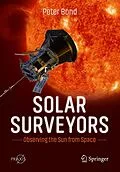This is the story of humankind's quest over centuries to learn the true nature of the most dominant object in our Solar System: the Sun.
Award-winning science writer Peter Bond describes in detail how our ideas about the Sun have changed over the millennia, starting with the simple observations of classical astronomy and continuing through telescopic observations to the age of nuclear physics. He shows how we discovered the Sun's basic characteristics - its distance, size, temperature and composition - and then describes how, with evermore sophisticated instruments, we have learned about the Sun's enormous energy output, its atmosphere and the explosive eruptions that blast clouds of magnetized gas and high-energy particles toward our world.
Most of this book focuses on the Space Age, when suborbital rockets and satellites have probed every aspect of our nearby star. Each of these missions is described in detail, with summaries of their objectives, spacecraftdesigns, scientific payloads and results. The book also looks forward, describing forthcoming missions that will shed new light on remaining solar mysteries, notably the source of the energy that heats the outer corona to millions of degrees.
Richly illustrated with mission photos, design diagrams, and infocharts, this book is a fascinating read for anybody interested in the Sun and our attempts to unravel its secrets.
Autorentext
Peter Bond has written 13 books, including the award-winning "DK Guide to Space", and has contributed to or acted as consultant / editor for many others. Peter has also written hundreds of articles on space and astronomy for British and American newspapers and magazines, as well as material for the Sunday Times "Window On The Universe" CD-ROM, the Nature-IOP "Encyclopedia of Astronomy and Astrophysics" and the Philips "Encyclopedia of Astronomy and Astrophysics". He has appeared many times on TV and radio to comment on the latest astronomical discoveries and events. He was Space Science Advisor / Press Officer for the Royal Astronomical Society 1995-2007, and was a consultant and writer for the European Space Agency for many years. He also edited the prestigious "IHS Jane's Space Systems & Industry" yearbook from 2008-2018.
Klappentext
This book is all about the Sun-its characteristics, how it impacts our planet, and all of our efforts to study our life-giving star from the 20th century to the present.
We begin with a description of what we have learned about the Sun using equipment located right here on our planet. This first section of the book includes a digestible introduction to solar physics, helping to familiarize readers with how the Sun operates and how it affects our planet.
This launches us into the meat of the story: a sweeping account of the many incredible solar missions launched over the decades, including SOHO and the Parker Solar Probe, and their critical contributions to solar physics.
Along the way, we will explore the deep space environment and the solar wind. Closer to home, we will take a look at the Sun-Earth interaction and solar phenomena like microflares. The complex instruments that made such missions possible are covered in detail, as are the current mission plans for the next wave of solar physics research.
Richly illustrated with mission photos, design diagrams, and infocharts, this book will be a fascinating read for anybody interested in the Sun and our attempts to research it.Inhalt
